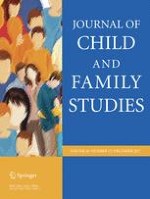02-08-2017 | Original Paper
Toward Developing Laboratory-Based Parent–Adolescent Conflict Discussion Tasks that Consistently Elicit Adolescent Conflict-Related Stress Responses: Support from Physiology and Observed Behavior
Gepubliceerd in: Journal of Child and Family Studies | Uitgave 12/2017
Log in om toegang te krijgenAbstract
Parent–adolescent conflict poses risk for youth maladjustment. One potential mechanism of this risk is that stress in the form of increased arousal during conflict interactions results in adolescents’ impaired decision-making. However, eliciting consistent adolescent stress responses within laboratory-based tasks of parent–adolescent conflict (i.e., conflict discussion tasks) is hindered by task design. This limitation may stem from how conflict topics are assessed and selected for discussion. Within a sample of 47 adolescents (ages 14–17) and parents, we investigated whether a modified version of a conflict discussion task could elicit physiological (i.e., arousal) and behavioral (i.e., hostility) displays of adolescents’ conflict-related stress responses. We assessed parent–adolescent conflict via structured interview to identify topics for dyads to discuss during the task. We randomly assigned dyads to complete a 5-min task to discuss either a putatively benign topic (i.e., control condition) or a conflict topic while undergoing direct assessments of continuous arousal. Trained raters coded dyad members’ hostile behavior during the task. Adolescents in the conflict condition exhibited significantly greater levels of arousal than adolescents in the control condition. We observed an interaction between discussion condition and baseline conflict. Specifically, higher baseline conflict predicted greater hostile behavior for adolescents in the conflict condition, yet we observed the inverse relation for adolescents in the control condition. Our modified laboratory discussion task successfully elicited both physiological and behavioral displays of adolescent conflict-related stress. These findings have important implications for leveraging experimental paradigms to understand causal links between parent–adolescent conflict and adolescent psychopathology, and their underlying mechanisms.
